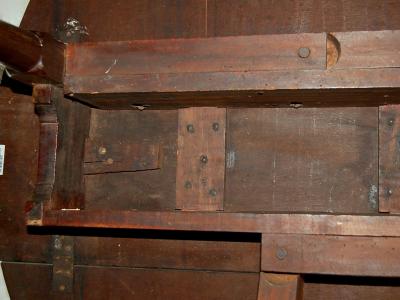Drop-leaf table
Rhode Island
1760-1790
Measurements
26-3/8 in x 36-1/4 in x 12-1/4 in (open, 38-1/4 in)
Materials
Mahogany; maple (inner frame)
Credit Line
Historic Odessa Foundation, bequest of H. Rodney Sharp
Accession Number
1968.804
Inscription
Each of the four table leaf hinges is stamped with a two-initial die, which may read “RF”.
Condition Notes
Inactive wood worm evidence appears on one fixed mahogany rail and one inner top rail.
Provenance
Ex coll. H. Rodney Sharp
Comments
The slightly oval drop-leaf or dining table stands on four legs with turned tapered shafts that end in off-set turned pad feet. The table maker then smoothed the edges of these two turning steps to create the ankles. This strategy was an easier and cheaper method of producing a leg that evoked stylish cabrioles. Such legs were made in most parts of the America and in Britain.
Origin of this table in Rhode Island stems largely from the unusual manner of securing the table top to the frame. The center section has short pieces of wood, called battens nailed to the underside of the top board. Two extend across the narrow dimenson of the frame, and two more attach at each end. Projecting ends of each batten form tenons that fit into mortises cut into the frame. In this way, the top board can expand and contract with changes in humidity without breaking glue joints, as with usual attachments. Another Rhode Island feature is the especially thick dimensions of the rails.

